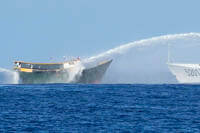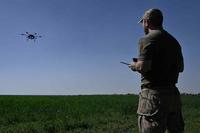This story, part of a series of investigative reporting projects by Military.com on service member and veteran health, was supported by the Pulitzer Center. You can read our first story on missileer cancer worries here.
The Air Force has deemed Vandenberg Space Force Base in California free of certain potentially dangerous contaminants following a study prompted by concerns over rising cancer rates and exposure to carcinogens among service members who work with America's nuclear missiles.
The findings, released publicly Monday, "found no instances of contamination above regulatory action levels" after testing for polychlorinated biphenyls, or PCBs, and volatile organic compounds that are believed to have negative health effects, Air Force Global Strike Command said in a statement. The Space Force base conducted surface testing and air sampling as part of the study.
Read Next: Camp Lejeune Sergeant Identified as Marine Killed During Training in North Carolina
Vandenberg, alongside America's three intercontinental ballistic missile bases -- Malmstrom Air Force Base in Montana, Minot Air Force Base in North Dakota and F.E. Warren Air Force Base in Wyoming -- have all undergone testing for potential contaminants that could be linked to an alarming number of illnesses such as breast cancer, prostate cancer and blood cancers being reported among the U.S. military's missileers and maintainers.
"Ensuring the most comprehensive assessment of the operational environments our nuclear team operates in, the U.S. Air Force School of Aerospace Medicine's team added our test and training sites at Vandenberg to the [missile community cancer study]," Lt. Gen. Michael Lutton, the deputy commander of Global Strike Command, said in a statement. "Leadership remains committed to a comprehensive, science-based, transparent [study] serving our nuclear force and families."
Vandenberg, located on California's Central Coast, provides training for approximately 450 missileers and maintainers every year, using simulators that look like the launch control centers and launch facilities where, if called upon, officers would be able to fire a nuclear intercontinental ballistic missile at a moment's notice.
Amid concerns from missileers and maintainers about carcinogens at nuclear missile bases, officials decided to evaluate the testing and training sites too.
Military.com has conducted a monthslong investigation into cancer among missileers that included government records requests, a two-day site visit to one of the nation's nuclear missile bases, and dozens of interviews with current and former Air Force missileers, as well as the relatives of some who have passed away amid wide-ranging cancer concerns related to potential carcinogenic exposure to substances in those Cold War-era facilities.
The newsroom's investigation found the U.S. government has overlooked evidence of cancer clusters for years. Two studies of missileer cancer clusters in the early 2000s failed to recognize the growing problem in the community, with that lack of recognition making it difficult for some missileers to prove to the Department of Veterans Affairs that their illnesses were related to military service, a precursor to securing some benefits.
The military branches also appear to have failed to account properly for contaminants that have been linked to cancer for decades, particularly PCBs, which were detected last year at unsafe levels in some missile facilities during an initial round of environmental sampling and cleaning efforts that are still underway at those bases.
PBCs were detected at one launch facility and one missile alert facility at Vandenberg, according to officials, but they were well below the Environmental Protection Agency's threshold.
"Because these are below regulatory cleanup levels, no additional remediation is required. These sites will be labeled and access limited to these areas to further limit risk to personnel," Air Force Global Strike Command said.
But missile maintainers have also raised concerns to Military.com about exposure to a wide variety of chemicals, toxins and carcinogens in the launch facilities, or LFs, where nuclear missiles are held.
Notably, certain soil and water samples were not taken at Vandenberg "as those are byproducts of agricultural operations and Vandenberg's simulators are not located near agricultural land," officials said. Additionally, surface samples were not taken for contaminants other than PCBs, and results from a 90-day radon sample are not yet complete.
Air Force officials announced the testing at Vandenberg, which does rocket launches and missile tests as well as missileer training, late last year as part of a wide-ranging and ongoing cancer and environmental study to address the missile community's concerns. The medical study began in March 2023, when former missileers raised concerns about high rates of blood cancers among former and current officers who had served at Malmstrom in Montana.
Officials said late last year that the results at Vandenberg would "help inform further LF testing" at other missile bases. It's not clear yet whether additional testing at other launch facilities will occur in the wake of the Vandenberg results, but officials said they are waiting for more data to inform future decisions.
The study is also examining cancer rates among missileers, security forces, maintainers, facility managers and other career fields that may be at risk from exposure to carcinogens and toxins.
Early results of that medical study, reported by Military.com last month, indicated elevated rates of breast and prostate cancers. But, so far, the research has looked only at Defense Department records. The current phase of the study did not include data from Department of Veterans Affairs medical records, the DoD cancer registry or the VA cancer registry, according to an Air Force Global Strike Command memo, and "captures fewer than 25% of total cancer cases" that will likely be found by the study, officials wrote.
That initial data on cancer rates includes DoD medical records from 2001 to the present, accounting for more than 2 million individuals. Of that number, officials found data covering roughly 84,000 missile community members, including 8,000 missileers.
It "is a limited slice of our population of interest," Air Force officials said, adding that "notably, it does not capture cases seen outside the military system."
The data set used for those initial findings found 198 cancer cases in the missile community, including 13 cases of female breast cancer, 24 cases of prostate cancer and 23 cases of non-Hodgkin lymphoma in that cohort.
As the Air Force studies the issue, Torchlight, a group of former missile community members who have created a grassroots advocacy organization for those diagnosed with cancer, is seeking a presumptive service exemption -- making it easier to get benefits -- from the VA.
In an April 12 response letter, the VA said it is looking into the group's request, adding that it "will continue to gather as much science and evidence as possible to move swiftly for veterans facing serious illnesses due to military exposures."












